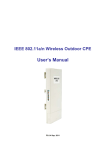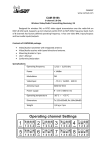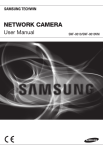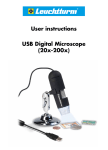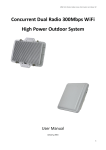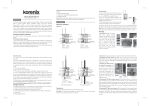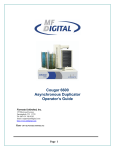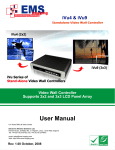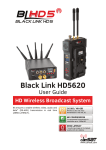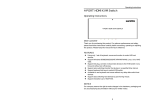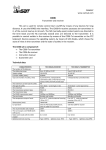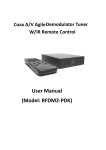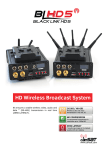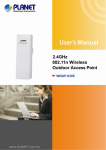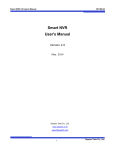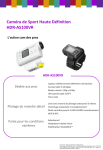Download User Manual
Transcript
WIRELESS TRANSMISSION SYSTEM FOR IP HD CAMERA EXTERNAL TRANSMITTING-RECEIVING UNIT CDS-5IP Quick Installation Guide Copyright Copyright © 2011 all rights reserved. No part of this publication may be reproduced, adapted, stored in a retrieval system, translated into any language, or transmitted in any form or by any means without the written permission of the supplier. About the Quick Installation Guide This Quick Installation Guide is intended to guide professional installer to install the CDS-5IP. It covers procedures to assist you in avoiding unforeseen problems. Conventions Warning: This sign indicates a warning or caution that you have to abide. Note: This sign indicates an important note that you must pay attention to. Chapter 1 Introduction Introduction CDS-5IP is a wireless transmission system designed to transmit audio / video in the 5GHz frequency band power of 1W (30dbi). The device transmits signals from IP cameras with high resolution (up to 5Mpixels). Built-in dual antenna 5GHz MIMO 2 x 16dBi allows signal transmission as standard to 2km, and the possibility of using fine-tuning function of the antenna provides high transmission quality even at varying distances. The additional two RP-SMA outputs give possibility to connect MIMO dual external antennas and thus significantly increase the operating range. CHARACTERISTICS - stable high-quality HD transmission in the 5GHz band, - 1W high radio power (30dbi) - Works in the point-to-point and point-to-multipoint configuration - OFDM radio modulation - Max speed 300Mbps - 64/128/152-bit transmission coding - Integrated MIMO dual antenna 2x16dbi and R-SMA outputs for additional antennas - link testing tool - PoE 15-18VDC / 0,8 A - Radio signal level indicator - LED indicators - RF power control - Works with all video resolutions - from VGA (640x480) by HD (1080p) to QSXGA (2560x2048) 3 Product Package The product package you have received should contain the following items. If any of them are not included or damaged, please contact your local vendor for support. CDS-5IP - Wireless External Video Unit ×1 Pole Mounting Ring ×2 Power Cord & POE Injector ×1 Product CD ×1 4 Chapter 2 Preparation before Installation This chapter describes safety precautions and product information you have to know and check before installing the CDS-5IP. Preparation before Installation Professional Installation Required Please seek assistance from a professional installer who is well trained in the RF installation and knowledgeable in the local regulations. Safety Precautions 1. To keep you safe and install the hardware properly, please read and follow these safety precautions. 2. If you are installing the CDS-5IP - Wireless External Unit for the first time, for your safety as well as others’, please seek assistance from a professional installer who has received safety training on the hazards involved. 3. Keep safety as well as performance in mind when selecting your installation site, especially where there are electric power and phone lines. 4. When installing the CDS-5IP, please note the following things: ♦ Do not use a metal ladder; ♦ Do not work on a wet or windy day; ♦ Wear shoes with rubber soles and heels, rubber gloves, long sleeved shirt or jacket. 5. When the system is operational, avoid standing directly in front of it. Strong RF fields are present when the transmitter is on. Page 5 Installation Precautions To keep the CDS-5IP - Wireless External Unit well while you are installing it, please read and follow these installation precautions. 1. Users MUST use a proper and well-installed grounding and surge arrestor with the Wireless External Video Unit; otherwise, a random lightening could easily cause fatal damage to the unit. EMD (Lightning) DAMAGE IS NOT COVERED UNDER WARRNTY. 2. Users MUST use the “Power cord & POE Injector” shipped in the box with the CDS-5IP. Use of other options will likely cause damage to the unit. 3. Users MUST power off the CDS-5IP - Wireless External Video Unit first before connecting the external antenna to it. Do not switch from built-in antenna to the external antenna from WEB management without physically attaching the external antenna onto unit; otherwise, damage might be caused to the unit itself. Page 6 Chapter 3 System Installation Connect up 1. The bottom of CDS-5IP - Wireless External Video Unit is a movable cover. screw with a Philips screwdriver. Loosen the Grab the cover and pull it back harder to take it out as the figure shown below. Figure 1 Move the Cover 2. Plug a standard Ethernet cable into the RJ45 port labeled “LAN 1”. Do not plug the cable into the RJ45 port labeled “LAN 2”. Figure 2 Cable Connection Page 7 The secondary Ethernet port (labeled LAN 2) is for IP camera or next CDS-5IP Unit video integration. To use it you need to enable the secondary port in advance before connecting with the IP camera from the CDS-5IP`s Web Management as shown below. 3. Take out the power cord and POE injector from the gift box, and plug the power cord into the DC port of the POE injector as the below picture shows. Figure 3 Connect to POE Injector 4. Put what in the Step.2 and Step.3 together by plugging the other side of the Ethernet cable in into the POE port of the POE injector When you finish the Step.4, the set will be like the following picture: Page 8 Figure 4 Plug the Ethernet cable to the RJ-45 jack of the injector 5. Press the black PWR button beside the LAN 1 Ethernet port. 6. Attach and fasten the removable cover to the bottom of the unit with the screw. 7. Power on the CDS-5IP - Wireless External Video Unit by plugging the power adapter to the power socket. Page 9 Using the External Antenna The CDS-5IP - Wireless External Video Unit provides two reverse SMA antenna connectors if you prefer to use the external antenna for your application instead of the built-in directional antenna, please follow the steps below. 1. Remove the two plugs as circled below: 2. Connect your external antenna to the SMA-type connectors at the bottom of the Wireless External Video Unit. Warning: Users MUST power off the CDS-5IP - Wireless External Video Unit first before connecting the external antenna to it. Do not switch from built-in antenna to the external antenna from WEB management without physically attaching the external antenna onto the unit; otherwise, damage might be caused to the unit itself. Follow the steps described in Connect Up to finish the installation. Page 10 Pole Mounting 1. Turn the Wireless External Video Unit over. Put the pole mounting rings through the middle hole of it. Note that you should unlock the pole mounting ring with a screw driver before putting it through the CDS-5IP as the following right picture shows. Figure 5 Pole Mounting – Step 1 2. Mount the CDS-5IP - Wireless External Video Unit steadily to the pole by locking the pole mounting ring tightly. 3. The mounting ring supports pole diameter 32mm to 70mm. Now you have completed the hardware installation of the CDS-5IP - Wireless External Video Unit . Page 11 Chapter 4 Configuration Connect the CDS-5IPwith your PC by an Ethernet cable plugging in LAN port of POE injector in one side and in LAN port of PC in the other side. Power on the CDS-5IP by POE from the supplied POE injector and press the black power button beside the LAN1 port. 1. Assign a static IP address to your PC which should be in the same network segment with the CDS-5IP. As the default IP address of the CDS-5IP is 192.168.1.1, you may choose from 192.168.1.2 to 192.168.1.254. Then click OK. 2. Open the web browser on your PC, key in the IP address (192.168.1.1) of the CDS-5IP in the address bar, and then press Enter. Page 12 3. Now, you will see the log-in page of the CDS-5IP. The default Name and Password are “camsat” and “camsat” respectively. Enter the password and then click Login. We’ll elaborate the CDS-5IP - Wireless External Video Unit factory default settings. You can re-acquire these parameters by default. If necessary, please refer to the “Restore Factory Default Settings”. Table 1 Factory Default Settings Features Factory Default Settings Username camsat Password camsat Wireless Unit Name CDS-5IP Operating Mode Video Bridge Data Rate Auto LAN IP Address 192.168.1.1 Subnet Mask 255.255.255.0 Gateway 0.0.0.0 Primary DNS Server 0.0.0.0 Secondary DNS Server 0.0.0.0 Spanning Tree Enable 802.11 Mode 802.11a/n Country/Region European Union Channel Number 5500 MHz (CH100) SSID CAMSAT Broadcast SSID Enable Page 13 HT Protect Disable Data Rate Auto Output Power Full Channel Mode 20MHz WMM Enabled RTS Threshold (byte) 2346 Fragmentation Length (byte) 2346 Beacon Interval 100 DTIM Interval 1 Space in Meter 0 Flow Control by AP Disable Security Open System Encryption None Wireless Separation Disable Access Control Disable For users who use the CDS-5IP - Wireless External Video Unit for the first time, it is recommended that you begin configuration from “Basic Settings” in “System” shown below: Page 14 TCP/IP Settings Open “TCP/IP Settings” in “System” as below to configure the parameters for LAN which connects to the LAN port of the CDS-5IP. In this page, users may change the settings for IP Address, Subnet Mask, and DHCP Server. Figure 6 TCP/IP Settings (Bridge) Obtain IP Address Automatically: If a DHCP server exists in your network, you can check this option, thus the CDS-5IP - Wireless External Video Unit is able to obtain IP settings automatically from that DHCP server. Since the CDS-5IP covers “Video Bridge mode”, “Master mode” as well as “Slave mode”, the following steps are categorized for convenience reading to describe how to set each mode after successful log-in. Page 15 Video Bridge Mode 1. Open “Basic Settings” in “Wireless”. From Wireless Mode, select “Video Bridge” and click “Apply” to save settings. 2. Go to “WDS Settings ” in “Wireless”, input the MAC address of the remote bridge to “Remote AP MAC Address 1” field and click “Apply”; Page 16 Note: Bridge uses the WDS protocol that is not defined as the standard thus compatibility issues between equipment from different vendors may arise. Moreover, Tree or Star shape network topology should be used in all WDS use-cases (i.e. if MASTER 2 and MASTER3 are specified as the WDS peers of MASTER1, MASTER2 should not be specified as the WDS peer of MASTER3 and MASTER3 should not be specified as the WDS peer of MASTER2 in any case). Mesh and Ring network topologies are not supported by WDS and should be avoided in all the use cases. 3. Repeat the above procedures to configure the remote CDS-5IP. 4. Use ping to check whether the link between the two bridges is OK. 5. To get a better wireless connectivity, antenna alignment is strongly recommended after both bridges are installed long distance apart. 6. Open “Antenna Alignment” in Tools. Choose the remote peer and click on the “Start” button. Page 17 7. Wait about 5 seconds, the antenna alignment starts and performs alignment every one second. 8. Fix the local antenna and adjust the remote antenna elevation and horizontal direction. During the adjustment, observe “Current RSSI” and “Signal Strength” in local bridge. The value will refresh every 1 second. Fix the remote antenna when it reaches your expectation. Usually, RSSI between -50 to -70dBm indicates rather good signal strength. 9. Adjust the local antenna after fixing the remote one. During the adjustment, observe “Current RSSI” and “Signal Strength” in the remote bridge. Fix the local antenna when it reaches your expectation. Under MASTER/SLAVE mode where Antenna Alignment Tool is not available, another option is provided to check the signal strength towards the connecting MASTER/SLAVE. Open “Connections” in “Status” as below, and click “Refresh” to view the current signal strength of wireless connectivity. If the signal is not so good, align the antenna manually. Page 18 Master Mode 1. Choose Wireless > Basic Settings. Then you will see the “Basic Settings” page. Here, you can set the parameters to optimize your application. Click “Apply” to save the parameters. In addition, for better coverage of the Master, you may also use external MIMO antennas; if so, remember to set the antenna setting from “Internal (16 dBi)” to “SMA Connector” after your external antennas are physically installed. Warning: Do not switch from built-in antenna to the external antenna from WEB management without physically attaching the external antenna onto the CDS-5IP; otherwise, damage might be caused to the device itself. Page 19 2. If security is required, open Wireless > Profile Setting and enter “VAP Profile 1 Settings” as below. You may set the parameters like “Network Authentication” and “Data Encryption” for more secure network communication in your application. Click Apply to save the parameters. Slave Mode 1. Choose Wireless > Basic Settings. Then you will see the “Basic Settings” page. Choose “SLAVE” from Wireless Mode, and click “Apply” to save it. Feel free to change the other parameters to optimize your application before clicking “Apply”. Note: For longer transmission of the CDS-5IP, you may also use an external antenna; if so, remember to set the antenna setting from “Internal (16 dBi)” to “SMA Connector” after your external antenna is successfully installed. Warning: Do not switch from built-in antenna to the external antenna from WEB management without physically attaching the external antenna onto the CDS-5IP; otherwise, damage might be caused to the device itself. Page 20 2. Click the “Site Survey” button beside SLAVE Mode. CDS-5IP within coverage. It will scan all the available Select the one you prefer to connect to, and click Selected to establish the connection. 3. If the MASTER you connect to require authentication or encryption keys, click Profile Settings in the left column, fill out the corresponding items, and click “ Apply” for data encryption. Page 21 Master Repeater Mode 1. Choose Wireless > Basic Settings. Choose “MASTER Repeater” from Wireless Mode, and click Apply to save it. Feel free to change the other parameters to optimize your application before clicking Apply. Note: For longer transmission of the CDS-5IP, you may also use an external antenna; if so, remember to set the antenna setting from “Internal (16 dBi)” to “SMA Connector” after your external antenna is successfully installed, otherwise do not switch to “SMA Connector)” without physically attaching the external antenna, otherwise, damage might be caused to device itself. Page 22 2. To establish point-to-point bridge connection, please follow the procedures described in Video Bridge Mode. To connect the wireless client to the MASTER, please follow the procedures described in SLAVE Mode. Congratulations! You have primarily completed configuration on the CDS-5IP and they can be put into operation. For more advanced configurations, please refer to the User manual. Page 23 General terms and conditions of a warranty Camsat company gives a warranty of 24 months for transmission sets of the following series: TCO 5807, CAM 5816, CDS 5021, CD04, CD06, CDS-5IP 1. In case of detecting incorrect work of a device, before giving the device to the service, it is necessary to make sure that everything was done in accordance with the instruction manual. 2. In case of giving or sending the faulty device to be repaired, it is indispensable to enclose a detailed description in the written form including faulty action of the device with taking into consideration work environment and the way in which they can be seen. 3. One can use the warranty if he shows the proof of purchase (a receipt) with the claimed device including the purchase date and a description of the damage. 4. The warranty repair includes only damages resulting from causes included in the sold device. 5. The warranty repair will be made in the shortest time possible not exceeding 14 days counting from the date of accepting the device to be repaired in the service. In case of a necessity to import parts, the repair date can be exceeded. After making the repair, the warranty period is exceeded by the time of repair. 6. The guarantor is not responsible for losing configuration settings of the device resulting from the repair of the device or its damage. 7. The guarantor can refuse making the warranty repair or completely renounce from the warranty in case of stating that seals on the devices or subsystems included in it are broken. 8. All remarks concerning the service and resulting from the warranty are made only in the service of the Camsat company. Page 24

























